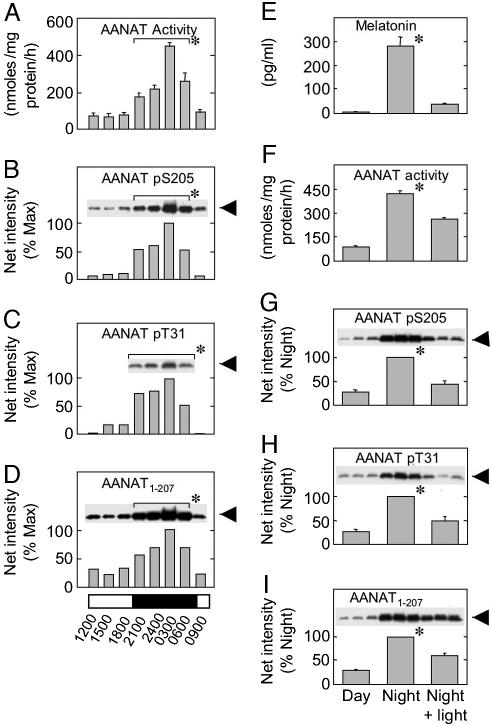Fig. 1.
Daily and light-induced changes in AANAT pS205 and related parameters. (A–D) Pineal glands were removed at the times indicated, and tissue extracts (1 mg/10 μl) were prepared. Representative results from a single study are presented. Similar results were obtained in two additional experiments. (E–I) Blood was obtained, and glands were removed during the day (≈1100 hours), at night (≈0200 hours), and at night after exposure to 30 min of light (≈0230 hours). At each time point, three pineal glands were removed under each lighting condition (1 pineal per supernatant, 75 μg per lane; proteins were resolved by SDS/PAGE). Blots were prepared in triplicate and immunodetected. The experiment was repeated three times, and the results were pooled; each bar represents the mean ± SE (n = 9). (A and F) AANAT activity in a gland was assayed in triplicate (1 mM tryptamine/0.5 mM [3H]acetyl-CoA; final specific activity, 4.2 Ci/mol; 20 min, 37°C). (B–D and G–I) Samples of supernatant (75 μg) were resolved by SDS/PAGE. Epitopes were detected with the following: AANAT pS205 and anti-oAANAT194–207 (As 5901); AANAT pT31 and anti-rAANAT22–37 pT31 (As 3352); and AANAT1–207 and anti-oAANAT1–207 (As 2819). (G–I) The three immunosignals that appear above each bar are representative of the nine samples used for quantitation of the corresponding bar. Immunosignals were captured on a Kodak Image Station 2000 mm and analyzed with Kodak 1d image-analysis software. The percent maximum value was calculated based on net intensity by using the highest night value as 100%. (E) Melatonin was measured by RIA. Data are presented as the mean ± SE (A and E–I) or the mean of two determinations (B–D). *, Statistical analysis: for the data shown in A–D, night (2100–0600 hours) samples were pooled, compared with a pool of day (0900–1800 hours) samples, and found to be statistically different (n = 8, P < 0.01); for the data shown in E–I, night values were found to be significantly (P < 0.01) greater than the day and the night + light groups. For additional details, see Materials and Methods.

